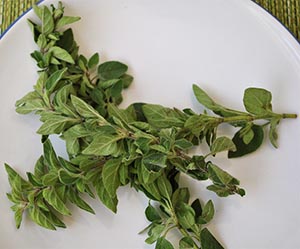Oregano Nutrition facts
Oregano is a wonderful perennial culinary and medicinal herb. It has long been recognized as one of the "functional foods" for its nutritional, antioxidant, and disease-preventing properties. The herb, whose name means "delight of the mountains" in Greek, is native to the Mediterranean region.
Botanically, it belongs to the mint (Lamiaceae) family, in the genus; Origanum, and is known scientifically as Origanum vulgare.
 |
| Oregano herb (Origanum vulgare). Photo courtesy: Cookbookman17. |
The plant is a small shrub, growing up to 75 cm in height with multi-branched stems covered with small grayish-green oval leaves and small white or pink flowers.
Oregano is widely popular in Greek and Italian cuisines. Its leaves have a distinctive aromatic, warm, and slightly bitter taste. Their biting intensity varies; for instance, good-quality oregano is so strong that it almost numbs the tongue.
There are many cultivars of oregano cultivated across Europe. However, the influences of climate, season, and soil have a greater influence on the composition of the essential oils than the species variations. Origanum heracleoticum is another Greek variety that has a distinctive sharp scent and flavor. Sweet marjoram (Origanum majorana) is one of the closely related species of oregano.
Mexican oregano (Lippia graveolens) is different from the rest of Origanum species but related to the verbena family of herbs. It is used in place of oregano in many Central American regions.
Health Benefits of Oregano
Oregano contains an impressive list of plant-derived chemical compounds that are known to have disease-preventing and health-promoting properties.
The herb parts contain no cholesterol; however, are a rich source of dietary fiber, which helps to control blood cholesterol levels.
Oregano contains much health benefiting essential oils such as carvacrol, thymol, limonene, pinene, ocimene, and caryophyllene. Its leaves and the flowering stem have antiseptic, antispasmodic, carminative, cholagogues (empties gallbladder collection of bile juice), diaphoretic (sweat production), expectorant, stimulant, and mildly tonic properties. Its decoction is taken by mouth for the treatment of colds, influenza, mild fevers, indigestion, stomach upsets, and painful menstruation conditions.
Thymol is also been found to have antibacterial, and antifungal activities.
The herb is rich in polyphenolic flavonoid antioxidants (vitamin A, carotenes, lutein, zeaxanthin, and cryptoxanthin) and has been rated as one of the plant sources with highest antioxidant activities. These compounds help act as protective scavengers against oxygen-derived free radicals and reactive oxygen species (ROS) that play a role in aging and various disease processes.
The active principles in the herb may improve gut motility, besides, increasing the digestion power by facilitating copious secretion of gastrointestinal juices.
This marvelous herb is an excellent source of minerals like potassium, calcium, manganese, iron, and magnesium. Potassium is an important component of cells and body fluids that helps control heart rate and blood pressure caused by high sodium. The human body utilizes manganese as co-factors for the antioxidant enzyme, superoxide dismutase. Iron helps prevent anemia. Magnesium and calcium are essential minerals for bone metabolism.
Also, fresh herb is an excellent source of antioxidant vitamin, vitamin-C. Vitamin C helps the human body develop resistance against infectious agents and scavenge harmful, pro-inflammatory free radicals.
Oregano is a proven super "functional food." This herb is one of the foundation bases of a healthy Mediterranean diet in addition to olive oil, fish, and lots of greens, herbs, and vegetables. It has an excellent nutritional profile; just 100 g of oregano herb provides:
Dietary fiber- 112% (Percent of RDA) (RDA-Recommended daily allowance).
Folates- 59%Pyridoxine- 80%
Vitamin-C- 4%
Vitamin-A-57%
Vitamin-K- 518%
Iron- 460%
Manganese-203%
Carotene-ß- 1007 µg
| Principle | Nutrient Value | Percent of RDA |
|---|---|---|
| Energy | 265 Kcal | 13% |
| Carbohydrates | 68.92 g | 53% |
| Protein | 9 g | 16% |
| Total Fat | 4.28 g | 21% |
| Cholesterol | 0 mg | 0% |
| Dietary Fiber | 42.5 g | 112% |
| Vitamins | ||
| Folates | 237 µg | 59% |
| Niacin | 4.640 mg | 29% |
| Pantothenic acid | 0.921 mg | 17% |
| Pyridoxine | 1.044 mg | 80% |
| Riboflavin | 0.528 mg | 40% |
| Thiamin | 0.177 mg | 15% |
| Vitamin-A | 1701 IU | 57% |
| Vitamin C | 2.3 mg | 4% |
| Vitamin E | 18.26 mg | 121% |
| Vitamin-K | 621.7 µg | 518% |
| Electrolytes | ||
| Sodium | 25 mg | 1.5% |
| Potassium | 1260 mg | 27% |
| Minerals | ||
| Calcium | 1597 mg | 160% |
| Copper | 0.633 mg | 70% |
| Iron | 36.80 mg | 460% |
| Magnesium | 270 mg | 67.5% |
| Manganese | 4.990 mg | 203% |
| Zinc | 2.69 mg | 24% |
| Phyto-nutrients | ||
| Carotene-ß | 1007 µg | -- |
| Crypto-xanthin-ß | 7 µg | -- |
| Lutein-zeaxanthin | 1895 µg | -- |
Selection and storage
Fresh as well as dried oregano can be readily available in herb stores all around the year. Try to buy fresh herb over its dried form since it is superior in flavor and richer in essential oils, vital vitamins, and antioxidants like β-carotene, vitamin C, and folates.
Choose fresh oregano leaves featuring a vibrant green color and a firm stem. It should be free from mold, discoloration, or yellowing. Try to buy dried oregano from the organic farm and process it from authentic sources since it assurances you that the product is free from irradiation and pesticide residues.
Fresh leaves should be stored in the refrigerator, kept in a zip pouch, or wrapped in a slightly damp paper towel. Dried leaves can be kept fresh for many months when stored in a tightly sealed glass container, and stored in a cool, dark, and dry place.
Culinary uses
In order to keep the fragrance and aromatic flavor intact, oregano leaves are generally used just prior to preparing recipes.
Here are some serving tips:
 |
| Delicious pizza with oregano topping. Photo courtesy: Craig |
Oregano herb is widely used as "spice." It is principally employed in the cuisines as a seasoning to enhance the flavor.
It has been used in the preparation of many popular dishes in Mediterranean and Mexican cuisine since ancient times. Along with other spicy items, it is being used as a flavoring agent in the preparation of pizzas, chicken, fish, and meat dishes.
It has also been used in the preparation of soups, omelets, sauces, and pickling.
Freshly chopped oregano leaves are a great addition to green/fruit salad.
Medicinal uses
The leaves and flowering stem of the oregano plant have antiseptic, antispasmodic, carminative, increased bile secretion, diaphoretic, expectorant, stimulant, and mildly tonic properties.
Oregano decoction is taken by mouth for the treatment of colds, influenza, mild fever, indigestion, stomach upsets, and painful menstruation.
Thymol has been found to have anti-septic, anti-bacterial, and anti-fungal activities. (Medical Disclaimer).
Safety profile
Oregano oil extracted from the herb parts may cause skin and mucus membrane irritation and hence, avoided in aromatherapy. (Medical disclaimer).
≻≻-Back to Herbs from Oregano nutrition. Visit here for an impressive list of all variety of herbs with complete illustrations of their nutrition facts and health benefits.
≻≻-Back to Home page.
Further Resources:
Stanford School of Medicine Cancer information Page- Nutrition to Reduce Cancer Risk (Link opens in new window).